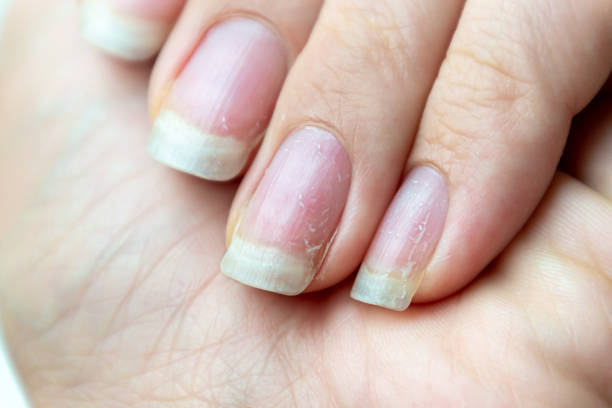
Nail White Spots
White spots, medically termed leukonychia, refer to white discoloration or markings that appear on the nail plate. They can vary in size, shape, and distribution.
These spots are usually harmless and often temporary, disappearing as the nail grows out. However, in some cases, they might indicate an underlying issue that needs attention.
In this article, we’ll explore the causes of white spots on fingernails, debunk myths, and provide practical advice on prevention and treatment.
Types of Leukonychia
True Leukonychia: This type occurs when the nail matrix (the tissue under the base of the nail that produces the nail plate) is damaged. The white spots or streaks are embedded in the nail and grow out with it.
Apparent Leukonychia: Unlike true leukonychia, this type is due to changes in the color of the nail bed (the skin under the nail). The discoloration is not embedded in the nail plate, meaning the white spots may disappear when pressure is applied to the nail.
Common Causes of White Spots on Fingernails
There are various potential causes of white spots on fingernails, ranging from harmless to more serious. Here are the most common reasons:
Injury or Trauma to the Nail Matrix
One of the most frequent causes of white spots is injury or trauma to the nail matrix. This damage can occur from:
- Banging your finger against a hard surface.
- Improper nail grooming or aggressive nail care techniques (e.g., cutting the cuticle too aggressively).
- Manicures or acrylic nail applications.
Since nails take time to grow, the white spot from trauma might not appear until weeks after the injury, which is why it can be difficult to link the cause.
Allergic Reactions
An allergic reaction to nail products like polish, nail hardeners, or acetone-based nail polish removers can cause white spots. If you frequently use these products, it’s a good idea to consider switching to hypoallergenic or less harsh alternatives.
Nutrient Deficiencies
While nutrient deficiencies are less common causes, they can sometimes contribute to the appearance of white spots. These deficiencies can include:
- Zinc: A lack of zinc can affect nail health, causing spots or brittle nails.
- Calcium: Though often cited as a cause, calcium deficiency is less commonly linked to white spots than previously believed.
- Protein: Low protein intake or absorption issues can sometimes lead to nail abnormalities.
Fungal Infections
A fungal infection, especially under the toenails, can lead to white or discolored patches. Though rare on fingernails, this type of infection can still cause the spots or streaks on the nail plate.
Systemic Health Issues
In rare cases, these spots on fingernails can indicate underlying health problems, such as:
- Kidney disease: Severe health conditions, like kidney disease, may cause specific changes in nail color and texture.
- Liver disease: Conditions like cirrhosis can cause the nails to become white or develop white spots.
- Heart conditions: Some cardiovascular diseases may cause discoloration of the nails.
If the spots persist, worsen, or are accompanied by other symptoms (e.g., fatigue, hair loss, or skin changes), it’s essential to consult a healthcare provider.
Myths About White Spots on Fingernails
One of the most widespread myths is that they are exclusively caused by a calcium deficiency. While a balanced diet rich in calcium is important for nail health, calcium deficiency is rarely the primary cause of leukonychia. Other myths include:
- Dehydration: There is no direct link between the condition and dehydration.
- Over-washing hands: While frequent washing can lead to dry or brittle nails, it doesn’t usually cause white spots.
How to Treat and Prevent White Spots on Fingernails
White spots on nails are typically harmless and don’t require specific treatment. However, there are steps you can take to improve nail health and reduce the likelihood of them appearing:
Moisturize and Care for Your Nails
Use a nourishing cuticle oil or hand cream daily to keep your nails and cuticles hydrated. This helps prevent brittleness and protects against potential trauma.
Gentle Nail Care
Avoid aggressive manicure techniques and be gentle when trimming cuticles or filing nails. If you use acrylic nails or nail polish frequently, consider giving your nails a break to allow them to recover naturally.
Consider Nutrient Supplements
If you suspect that a deficiency in zinc or protein may be the cause, consider boosting your intake through food or supplements. Foods rich in zinc include nuts, seeds, and lean meats, while protein can be found in eggs, legumes, and fish.
Address Allergies
If you’ve noticed white spots after using certain nail products, it’s possible you’re experiencing an allergic reaction. Switch to hypoallergenic nail polish or acetone-free nail polish remover to minimize irritation.
Consult a Doctor for Persistent Cases
If the spots continue to reappear, cover large areas of the nail, or are accompanied by other health issues, it’s best to consult a healthcare provider. They can evaluate for potential underlying conditions or recommend specific treatments if needed.
In Conclusion
White spots on fingernails, though often harmless, can sometimes be a sign of an underlying issue. Understanding the causes, from trauma to possible nutrient deficiencies, allows for better prevention and treatment.
Simple steps like moisturizing your nails, maintaining a balanced diet, and avoiding harsh nail products can go a long way in keeping your nails healthy and spot-free. If persistent spots or other nail abnormalities occur, consulting with a healthcare professional is always the best course of action.
Read Also: Phases of Menstrual Cycles







